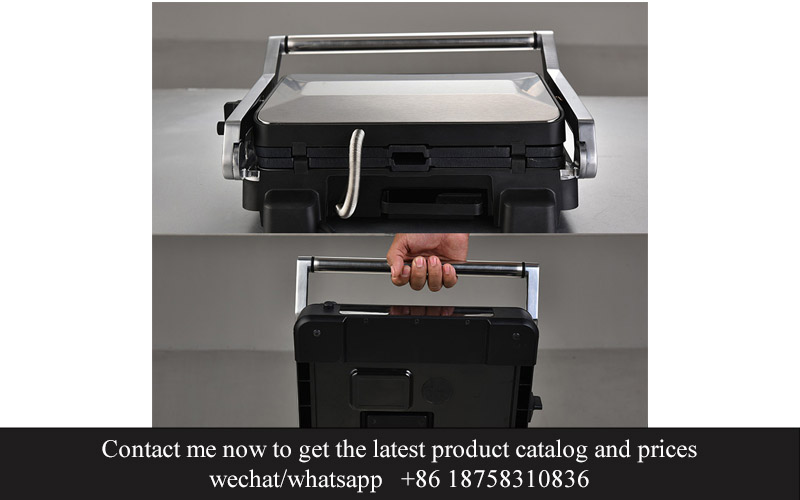Address
304 North Cardinal
St. Dorchester Center, MA 02124
Work Hours
Monday to Friday: 7AM - 7PM
Weekend: 10AM - 5PM
Address
304 North Cardinal
St. Dorchester Center, MA 02124
Work Hours
Monday to Friday: 7AM - 7PM
Weekend: 10AM - 5PM

In a world where technology and consumer expectations are advancing at lightning speed, the kitchen appliances industry is undergoing a transformative phase. This shift is not just about the products themselves, but also about how they are designed, manufactured, and integrated into our daily lives. As we delve into the evolving landscape of kitchen appliances, it’s clear that innovation and adaptation are key to staying ahead in this dynamic market.
The Growing Trend of Import Substitution in Kitchen Appliances
In recent years, the kitchen appliances industry has witnessed a significant shift towards import substitution, a trend that is reshaping the competitive landscape of the European and American markets. This movement is not just about local production; it’s a strategic endeavor to bolster domestic industries, reduce dependency on foreign suppliers, and ultimately, enhance economic resilience.
As consumers become more environmentally conscious and value local craftsmanship, the demand for domestically produced kitchen appliances has surged. This shift is being driven by several key factors:
Economic Nationalism: Governments in both Europe and the Americas are increasingly focusing on promoting domestic industries as a means to reduce trade deficits and support local economies. This has led to a rise in import substitution programs that incentivize the production and consumption of locally made appliances.
Quality Concerns: Consumers are becoming more discerning about the quality and durability of their kitchen appliances. With a growing preference for products that meet or exceed international standards, local manufacturers are stepping up their game to fill the void left by imported goods.
Environmental Impact: The environmental movement has played a pivotal role in the import substitution trend. Local production reduces carbon footprints associated with long-distance shipping, and consumers are increasingly choosing appliances that align with their sustainability values.
Technological Advancements: Local suppliers are leveraging technological advancements to produce high-quality, innovative kitchen appliances. These advancements are closing the gap between local and international brands, making domestic products more competitive.
Cultural Relevance: There is a growing recognition of the importance of cultural identity in consumer choices. Local appliances often reflect regional design aesthetics and functionalities, which resonate with consumers looking for products that are both practical and culturally relevant.
The impact of import substitution in the kitchen appliances sector is multifaceted:
However, the path to successful import substitution is not without challenges:
Despite these challenges, the trend of import substitution in kitchen appliances is gaining momentum. Suppliers are responding by investing in research and development to innovate and improve their products. They are also forming strategic partnerships to enhance their capabilities and expand their market reach.
In conclusion, the growing trend of import substitution in the kitchen appliances industry is a testament to the evolving consumer landscape and the strategic decisions of governments and businesses alike. As this trend continues to unfold, it will be interesting to observe how the industry adapts and evolves, ultimately shaping the future of kitchen appliances in Europe and the Americas.

In Europe, the kitchen appliances market is a blend of tradition and innovation, with a strong emphasis on sustainability and energy efficiency. Consumers here are increasingly looking for appliances that not only enhance their lifestyle but also align with their values. The market is segmented into various categories, including refrigerators, dishwashers, ovens, and small appliances like toasters and blenders.
The European market is characterized by its matured consumer base, which demands high-quality and durable products. Brands like Siemens, Bosch, and Miele have long been synonymous with excellence in kitchen appliances. However, this market is also witnessing a shift towards local manufacturing and import substitution, driven by economic and environmental concerns.
On the other hand, the Americas, particularly the United States and Canada, offer a diverse landscape with a mix of large urban centers and sprawling suburban areas. The U.S. market is known for its innovation and technological advancements, with a preference for smart and connected appliances. Brands like KitchenAid, Whirlpool, and LG have a significant presence, offering a wide range of products to cater to different consumer needs.
In the Americas, the kitchen appliances market is heavily influenced by trends in home design and cooking culture. For instance, the rise of outdoor kitchens and the demand for high-end appliances in luxury homes have become notable trends. Additionally, the market is seeing a growing interest in energy-saving appliances, as consumers become more environmentally conscious.
The U.S. and Canadian markets also differ in their retail landscapes. The U.S. has a strong presence of big-box retailers like Home Depot and Lowe’s, while Canada features a mix of large retailers and specialized kitchen appliance stores. This diversity in distribution channels affects the marketing strategies and product offerings of manufacturers.
In Europe, the market dynamics are further shaped by regulations and standards. The European Union’s Energy Labeling Directive is a prime example, requiring appliances to display energy consumption information, which helps consumers make informed choices. Additionally, the WEEE (Waste Electrical and Electronic Equipment) Directive has influenced the design and recycling of appliances, pushing manufacturers towards more sustainable practices.
In the Americas, regulatory landscapes vary by country. The U.S. Energy Star program is a voluntary labeling program that promotes energy-efficient products, while Canada has its own EnerGuide label. These programs not only inform consumers but also serve as a competitive advantage for manufacturers that can meet or exceed these standards.
The kitchen appliances market in both Europe and the Americas is also influenced by demographic shifts. Aging populations in Europe are driving demand for appliances that cater to specific needs, such as easy-to-use controls and larger capacities. In the Americas, the trend towards smaller households and single-person living is prompting manufacturers to create more compact and versatile products.
In conclusion, the market dynamics in Europe and the Americas are complex and multifaceted. They are shaped by consumer preferences, technological advancements, regulatory frameworks, and cultural nuances. Understanding these dynamics is crucial for manufacturers looking to succeed in these regions, as it requires a nuanced approach to product development, marketing, and distribution.

In the ever-evolving landscape of kitchen appliances, innovation is the driving force behind the latest trends. From smart technology integration to eco-friendly designs, the following ideas are revolutionizing the way we think about our kitchens.
Smart Connectivity Redefining ConvenienceThe integration of smart technology has transformed kitchen appliances into connected devices. Imagine a refrigerator that can track your groceries and suggest recipes based on your inventory. Smart ovens that can be controlled remotely, and dishwashers that optimize their cycles for the best energy efficiency. These innovations are not just about convenience; they’re about creating a seamless, efficient kitchen experience.
Energy Efficiency at the CoreEnergy efficiency has become a cornerstone in the design of modern kitchen appliances. Manufacturers are focusing on reducing energy consumption without compromising performance. This includes the development of LED lighting in cooktops and refrigerators, as well as induction cooktops that heat food faster and use less energy than traditional electric or gas burners.
Eco-Friendly Materials and DesignSustainability is a growing concern, and kitchen appliance manufacturers are responding with eco-friendly materials and designs. From biodegradable packaging to appliances made from recycled materials, the industry is moving towards a greener future. Additionally, appliances with longer lifespans and replaceable parts are becoming more common, reducing the need for frequent replacements.
Personalized Cooking ExperiencesCustomization is another area where innovation is thriving. Smart appliances can now learn your cooking preferences and adjust settings accordingly. From the perfect steak to a cup of coffee just the way you like it, these appliances are designed to cater to individual tastes and needs.
Interactive and Educational FeaturesModern kitchen appliances are not just tools for cooking; they are interactive and educational. For instance, ovens equipped with recipe guides and cooking tutorials can help even the most inexperienced chefs. Some appliances even provide nutritional information and cooking times, making it easier to plan balanced meals.
Advanced Food Storage SolutionsThe way we store food is also being reimagined with new innovations. Refrigerators with humidity-controlled drawers for delicate fruits and vegetables, or freezers with vacuum-sealing capabilities to extend the life of frozen foods, are becoming standard features. These advancements ensure that food stays fresher for longer, reducing waste.
Innovative Cooking TechniquesTraditional cooking methods are being challenged by new technologies. Air fryers, which use hot air to crisp food, are becoming popular for their health benefits and ability to mimic the taste of fried food without the oil. Induction cooktops offer precise temperature control, making them ideal for delicate sauces and precise cooking times.
Safety and AccessibilitySafety features are paramount in kitchen appliances, and innovation in this area is ongoing. From childproof locks on ovens and refrigerators to automatic shut-off features in cooktops, these appliances are designed to prevent accidents. Moreover, accessibility features such as voice-controlled appliances and easy-to-use interfaces cater to a wider range of users, including those with disabilities.
The Future of CookingThe future of kitchen appliances is bright with endless possibilities. We can expect to see even more advanced features that blend convenience, efficiency, and sustainability. As technology continues to advance, the kitchen will become a hub of innovation, where appliances not only make cooking easier but also enhance our daily lives in unexpected ways.

In the ever-evolving landscape of kitchen appliances, staying abreast of the latest industry trends and conducting thorough data analysis is crucial for suppliers and manufacturers. Here’s a glimpse into some of the current trends and the insights they offer:
Smart Integration and ConnectivityModern kitchen appliances are not just tools for cooking and cleaning; they are becoming integral parts of the smart home ecosystem. Smart refrigerators, ovens, and dishwashers are now equipped with connectivity features that allow users to control them remotely via smartphones or voice assistants. This trend is driven by the increasing demand for convenience and efficiency, as well as the growing interest in home automation.
Energy Efficiency and SustainabilityAs environmental concerns rise, so does the importance of energy-efficient appliances. Consumers are increasingly looking for products that not only save them money on utility bills but also have a lower carbon footprint. Data analysis shows a significant shift towards appliances with higher energy ratings and those made from sustainable materials. This trend is shaping the way manufacturers design and market their products.
Health and Wellness FeaturesWith the rise of health consciousness, kitchen appliances are now being designed with features that promote wellness. For instance, air fryers and slow cookers are gaining popularity due to their ability to prepare healthier meals with minimal oil and fat. Smart appliances that can track nutritional content and offer personalized meal plans are also catching on. Data indicates a growing market segment focused on health and wellness solutions in kitchen appliances.
Customization and PersonalizationThe kitchen is no longer a one-size-fits-all space. Consumers are seeking appliances that can be customized to their specific needs and preferences. From adjustable oven racks to dishwashers that can be programmed for different soil levels, the industry is responding with a variety of options. Data from market research suggests that customers are willing to pay a premium for appliances that offer a high degree of personalization.
Artificial Intelligence and Machine LearningAI and machine learning are making their way into kitchen appliances, offering a level of intelligence that was once only seen in science fiction. Appliances that can learn from usage patterns, predict maintenance needs, and even suggest recipes based on available ingredients are becoming more common. The data shows a promising future for AI-driven appliances, with a projected increase in sales as consumer interest grows.
E-commerce and Direct-to-Consumer SalesThe rise of e-commerce has changed the way consumers purchase kitchen appliances. Direct-to-consumer (DTC) sales are on the rise, with manufacturers offering products directly to consumers online. This trend is driven by the convenience of online shopping and the desire for a more personalized buying experience. Data from e-commerce platforms reveals a surge in online sales, particularly for high-tech and premium appliances.
Urbanization and Compact AppliancesAs urban populations grow, so does the need for compact and space-saving kitchen appliances. Micro-apartments and smaller living spaces are prompting manufacturers to design more efficient and multi-functional appliances. Data indicates a strong demand for products like compact refrigerators, countertop ovens, and portable dishwashers, which cater to the needs of urban dwellers.
Globalization and Cross-Regional TrendsGlobalization has led to the spread of kitchen appliance trends across different regions. For example, the popularity of induction cooktops in Europe is now being mirrored in other markets. Data analysis shows that cross-regional trends are influencing the design and marketing strategies of kitchen appliances worldwide.
In conclusion, the kitchen appliance industry is experiencing a transformation driven by a multitude of factors, from technological advancements to changing consumer preferences. By analyzing the latest trends and data, suppliers and manufacturers can better understand the market dynamics and position themselves for success in this dynamic sector.

The surge in import substitution programs across various sectors has undeniably made its mark in the kitchen appliances market. These initiatives are not just about protecting domestic industries; they’re reshaping the landscape for local suppliers. Let’s delve into the profound impact these programs have on the very fabric of local supply chains.
Local suppliers are finding new opportunities to thrive as import substitution policies gain traction. By fostering domestic production, these programs create a supportive environment that encourages innovation and growth within the local industry. The ripple effect is substantial, from raw material suppliers to manufacturers and even retailers.
One significant outcome is the boost in local manufacturing capabilities. Suppliers that once sourced components from abroad are now investing in their own production facilities, leading to improved quality and reduced dependency on imported goods. This shift has not only strengthened the local economy but also enhanced the competitiveness of domestic brands.
The demand for eco-friendly and energy-efficient appliances has surged, and local suppliers are stepping up to meet this demand. With import substitution programs promoting domestic production, suppliers are now able to cater to the growing market for green appliances, which is becoming a pivotal trend in Europe and the Americas.
Moreover, the rise of smart kitchen technology is creating new avenues for local suppliers. As consumers increasingly seek out appliances that offer connectivity and smart features, local manufacturers are responding with innovative solutions. This demand-driven innovation is not only attracting consumers but also positioning local suppliers as key players in the global market.
The impact of import substitution programs is also evident in the area of job creation. With the expansion of domestic manufacturing, local suppliers are hiring more workers, which in turn stabilizes communities and reduces the reliance on foreign labor. This economic empowerment of local communities is a cornerstone of these programs.
However, it’s not all smooth sailing for local suppliers. The transition to domestic production can be challenging, especially for those who have been deeply integrated into global supply chains. There’s a learning curve involved in adapting to new production methods and meeting stringent quality standards. This period of adjustment can lead to temporary disruptions in supply and increased costs.
Furthermore, the reliance on domestic markets can sometimes stifle competition and innovation. While import substitution programs aim to bolster local industries, they must also ensure that the market remains open to healthy competition. Otherwise, suppliers might fall into a complacent state, leading to a lack of drive for continuous improvement.
The role of government in supporting these programs cannot be overstated. Subsidies, tax incentives, and technical assistance are crucial in helping local suppliers bridge the gap between current capabilities and the advanced technology required to compete globally. Government initiatives are also vital in setting up industry standards and ensuring that quality does not suffer in the pursuit of domestic production.
Another challenge is the issue of scale. Local suppliers may find it difficult to match the economies of scale that come with large international suppliers. This can limit their ability to compete on price, especially in the early stages of the import substitution process. Overcoming this challenge requires strategic partnerships and collaborations that can help pool resources and spread costs.
Despite these challenges, the long-term benefits of import substitution programs for local suppliers are clear. By focusing on domestic production, suppliers can establish a strong foundation for growth and resilience. They can leverage their local market knowledge to create tailored products that resonate with consumers, and they can contribute to the development of a more sustainable and self-reliant economy.
In conclusion, the impact of import substitution programs on local suppliers is multifaceted. While it presents opportunities for growth and innovation, it also demands adaptation and strategic planning. The success of these programs hinges on the ability of local suppliers to navigate these challenges and capitalize on the new opportunities that arise. As the kitchen appliances market continues to evolve, the role of local suppliers in shaping its future is undeniable.

In the realm of import substitution, several initiatives have shown remarkable success, reshaping the landscape of local suppliers. Let’s delve into a few case studies that highlight the impact and benefits of these programs.
One such initiative is the “Made in Italy” campaign, which has been a beacon of pride and economic empowerment for Italian manufacturers. By focusing on producing high-quality kitchen appliances domestically, the campaign has not only bolstered local industries but also redefined consumer expectations. Italian suppliers have leveraged their rich heritage in craftsmanship to create products that are synonymous with excellence, thereby reducing the reliance on foreign imports.
Another shining example is the “Buy Local, Build Local” program in Mexico. This initiative was launched to support the domestic manufacturing of kitchen appliances in response to the rising costs of imported goods. Local suppliers have stepped up to the challenge, developing cutting-edge technologies and designs that cater to both the domestic and export markets. The program has not only created jobs but has also led to a surge in innovation, with several Mexican brands emerging as global competitors.
In Brazil, the government’s “Brazilian Appliances” program has been a game-changer. By offering incentives and subsidies to local manufacturers, the program has encouraged the production of high-quality, affordable kitchen appliances. This has not only made life easier for Brazilian consumers but has also strengthened the country’s manufacturing sector. Local suppliers have capitalized on this opportunity to invest in research and development, leading to the creation of appliances that are both efficient and sustainable.
The success of the “Made in Germany” brand is another testament to the power of import substitution. German suppliers have consistently pushed the boundaries of innovation, producing appliances that are known for their durability and efficiency. By focusing on quality over quantity, German manufacturers have managed to carve out a niche in the global market, reducing the need for imports and reinforcing the domestic supply chain.
In the United States, the “American Made” movement has gained traction, particularly in the kitchen appliances sector. Local suppliers have taken advantage of the trend towards sustainability and eco-friendly products to develop appliances that are not only energy-efficient but also support local economies. This has led to a surge in demand for American-made kitchen appliances, as consumers seek to reduce their carbon footprint and support domestic manufacturing.
One notable case is the “Buy American, Hire American” policy, which has encouraged the domestic production of kitchen appliances. This has resulted in the creation of jobs and the strengthening of local supply chains. Suppliers have responded by investing in advanced manufacturing technologies and skilled labor, ensuring that American-made appliances remain competitive on the global stage.
In South Korea, the “Korean Wave” of kitchen appliances has swept the region, driven by local suppliers who have embraced innovation and quality. By focusing on smart appliances that integrate seamlessly with modern lifestyles, Korean manufacturers have been able to capture a significant share of the global market. This has reduced the need for imports and has propelled the growth of local suppliers.
These case studies demonstrate that import substitution programs can have a profound impact on local suppliers. By fostering innovation, creating jobs, and encouraging sustainable practices, these programs have not only strengthened domestic industries but have also positioned local suppliers as key players in the global market. As the world continues to navigate the complexities of international trade, the success of these initiatives serves as a reminder of the power of local ingenuity and the benefits of investing in domestic manufacturing.

The integration of smart technology in kitchen appliances has paved the way for a more interconnected and efficient culinary experience. From voice-activated ovens to smart refrigerators that can manage inventory, the future of kitchen appliances is all about seamless integration with our daily lives. We’re seeing a shift from standalone devices to a holistic kitchen ecosystem that communicates and collaborates with one another.
Automated cooking systems are not just a convenience but a necessity for those with busy schedules. These systems can take the guesswork out of meal preparation, ensuring that food is cooked to perfection every time. The rise of AI in kitchen appliances is expected to continue, with systems that can learn and adapt to individual preferences and dietary needs.
Energy efficiency is a growing concern, and appliances are becoming more eco-friendly. Innovations like solar-powered kitchen gadgets and induction cooktops that reduce energy consumption are becoming increasingly popular. As environmental consciousness grows, so does the demand for sustainable and energy-saving kitchen solutions.
The rise of modular kitchen appliances is another trend that’s shaping the future. These are designed to be customized and can be easily swapped out or upgraded as technology advances. Think of a modular oven that can be transformed into a convection microwave or a countertop appliance that can be turned into a full-fledged countertop kitchen. This modular approach allows for flexibility and scalability, ensuring that kitchens can evolve with the homeowner’s changing needs.
Personalization is also taking center stage in kitchen appliance innovation. Customizable colors, finishes, and even features are becoming more common, allowing homeowners to create a kitchen that reflects their unique style and preferences. We’re seeing a move away from the one-size-fits-all approach to a more individualized and tailored kitchen experience.
The Internet of Things (IoT) is another driving force behind the innovation in kitchen appliances. With IoT, kitchen appliances can connect to the internet and to each other, offering a level of convenience and control that was once unimaginable. Imagine a scenario where your smart oven automatically adjusts the temperature based on the weather forecast, or your fridge can suggest recipes based on the ingredients you have in stock.
Sustainability and ethical manufacturing are becoming more important considerations. Consumers are not only looking for appliances that are energy-efficient but also those that are produced in an environmentally responsible manner. Brands that prioritize sustainability and ethical sourcing are likely to gain a competitive edge in the market.
Health and wellness are at the forefront of kitchen appliance innovation. We’re seeing a surge in appliances designed to promote healthy cooking, such as steam ovens that retain more nutrients than traditional ovens, and air fryers that provide a healthier alternative to deep-frying. Additionally, kitchen appliances that can track and analyze nutritional content are becoming more prevalent, helping consumers make informed choices about their meals.
In the realm of connectivity, we’re moving towards a future where kitchen appliances are not just smart but also socially aware. Imagine a scenario where your kitchen appliances can recognize and interact with family members, providing them with personalized recommendations and assistance. This level of personalization and interaction is likely to become more common as technology becomes more intuitive and less intimidating.
The future of kitchen appliances is also about accessibility. Innovations that make appliances easier to use for people with disabilities or those who may have difficulty with traditional controls are gaining traction. From voice activation to simple, intuitive interfaces, the goal is to create appliances that are inclusive for everyone.
Lastly, we should expect to see a greater emphasis on the after-sales service and support. As appliances become more complex, the need for reliable customer service and technical support will increase. Brands that offer comprehensive service packages and ongoing support are likely to build stronger customer loyalty and trust. The future of kitchen appliances is not just about innovation and technology; it’s about creating a seamless, user-friendly, and sustainable kitchen experience that caters to the diverse needs of consumers worldwide.

The shift towards sustainability has become a driving force in the kitchen appliances industry, prompting a wave of innovation that promises a greener, more efficient future. From smart appliances that reduce energy consumption to materials that are recyclable, the industry is on the cusp of a transformation. Consumers are increasingly seeking products that align with their environmental values, and manufacturers are responding by integrating eco-friendly features into their designs.
The integration of renewable energy sources into kitchen appliances is another significant trend. Solar-powered refrigerators and dishwashers, for instance, are not just futuristic concepts but are becoming more accessible and affordable. As technology advances, these appliances will become more efficient, reducing the carbon footprint of households and contributing to a cleaner environment.
Smart technology is not only changing how we interact with our kitchen appliances but also how they interact with each other and with the home ecosystem. The Internet of Things (IoT) is paving the way for interconnected appliances that can optimize energy use, provide personalized settings, and even alert homeowners to potential issues before they become problems. This level of connectivity enhances convenience and efficiency, making kitchen appliances an integral part of a smart home.
Energy efficiency remains a cornerstone of innovation in the kitchen appliances market. Newer models are designed with energy-saving features that not only reduce utility bills but also lower the overall environmental impact. The adoption of LED lighting, efficient motors, and advanced insulation are just a few examples of how appliances can consume less energy without compromising on performance.
The customization of kitchen appliances is also gaining traction. Consumers are no longer limited to one-size-fits-all solutions. Customizable appliances allow users to tailor their kitchen equipment to their specific needs and preferences. From adjustable cooking temperatures to modular components, the market is evolving to meet the diverse requirements of today’s consumers.
As the industry continues to evolve, there’s a growing emphasis on ethical manufacturing practices. Brands are under pressure to ensure that their products are not only innovative but also produced in a manner that respects human rights and the environment. This means sourcing materials responsibly, maintaining fair labor conditions, and reducing waste throughout the supply chain.
The rise of eco-friendly materials is another trend that’s reshaping the kitchen appliances landscape. Biodegradable plastics, recycled metals, and sustainable woods are becoming more common, reflecting a commitment to sustainability from both manufacturers and consumers. These materials not only reduce the environmental impact of appliances but also provide a premium aesthetic appeal.
Innovation isn’t just about creating new products; it’s also about rethinking the way we use existing technologies. For example, the integration of 3D printing into the production process allows for rapid prototyping and customization. This technology can enable manufacturers to produce appliances that are tailored to the exact needs of individual consumers, reducing waste and improving efficiency.
The impact of technology on kitchen appliances extends beyond just the devices themselves. The rise of e-commerce has changed how consumers purchase these products. With more people shopping online, there’s a greater emphasis on product reviews, ease of delivery, and after-sales service. This shift has prompted manufacturers to focus on enhancing the overall customer experience.
The future of kitchen appliances is also tied to the global demand for healthier living. Appliances that promote healthy cooking methods, such as steam ovens and air fryers, are becoming more popular. These innovations cater to consumers who are looking for healthier alternatives to traditional cooking methods that can be less healthy due to oil usage or high heat.
Lastly, the integration of artificial intelligence (AI) into kitchen appliances is poised to revolutionize the industry. AI-powered appliances can learn from usage patterns, predict maintenance needs, and even suggest recipes based on the ingredients available in the kitchen. This level of intelligence not only adds convenience but also enhances the efficiency and safety of kitchen appliances.
In conclusion, the kitchen appliances industry is in a state of continuous evolution, driven by consumer demands, technological advancements, and environmental concerns. Embracing change is crucial for sustainable growth, and the industry is well on its way to delivering products that are not only innovative but also responsible and efficient.